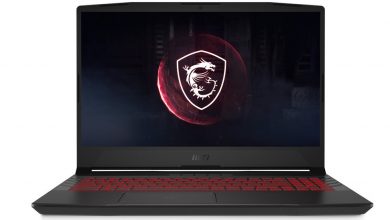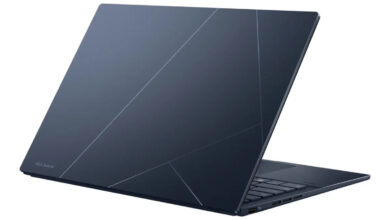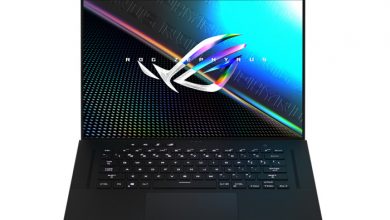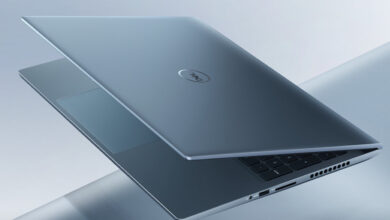Since its official release in 2020, the Lenovo Legion 5i has been doing quite well. Considering its release time (at the hub of the pandemic), this device has been in short supply. However, the pandemic is not the only reason why this device has been in short supply. It is also a high-power and attractive notebook. However, this year, the company updated the Lenovo Legion 5i with a new AMD Ryzen 5000 series CPU as well as an NVIDIA GPU. We also reviewed the Lenovo Legion 5 Pro that was released at the same time not long ago.
The new Lenovo Legion 5i comes with the latest AMD Ryzen R7-5800H and Nvidia RTX3060 GPU. The display is a 165Hz 1080P resolution IPS matte screen with 16GB of RAM and 512GB SSD.
Lenovo Legion 5i Specifications
| Screen | 15.6″ FHD (1920 x 1080) IPS, 165Hz refresh rate, <3 ms response time, 100% sRGB, 300 nits, Dolby Vision supported, AMD FreeSync Premium |
| Processor | AMD Ryzen 7 5800H (3.2GHz, up to 4.40GHz, 8 Cores, 16 Threads, 16MB Cache) |
| Wireless Connection | WiFi 6 802.11AX (2 x 2); Bluetooth® 5.1 |
| Graphics card | NVIDIA GeForce RTX3060, 6GB GDDR6, Maximum Graphics Power 130W |
| Memory | 16GB DDR4 3200MHz |
| Storage | 512GB M.2 NVMe PCIe SSD |
| Camera | HD 720p with E-Shutter |
| Ports | USB-C 3.2 Gen 2 (DisplayPort™ 1.4), Headphone/mic combo, USB-A 3.2 Gen 1, E-Shutter button, 3 x USB-A 3.2 Gen 1, USB-C 3.2 Gen 2 (DisplayPort™ 1.4 & power delivery), HDMI 2.1, RJ45, Power input |
| Battery | 80Wh |
| OS | Windows 10 Home |
| Weight | 2.4kg / 5.3lbs |
Lenovo Legion 5i Review: Design & Appearance
The Lenovo Legion 5i comes with a very simple but attractive design. This notebook has two logos: the Lenovo logo on one side of the top surfaces and a LEGION logo that is diagonal to the Lenovo logo. The top surface uses a plastic matte build material which feels good to the touch, but the disadvantage is that it easily attracts fingerprints.
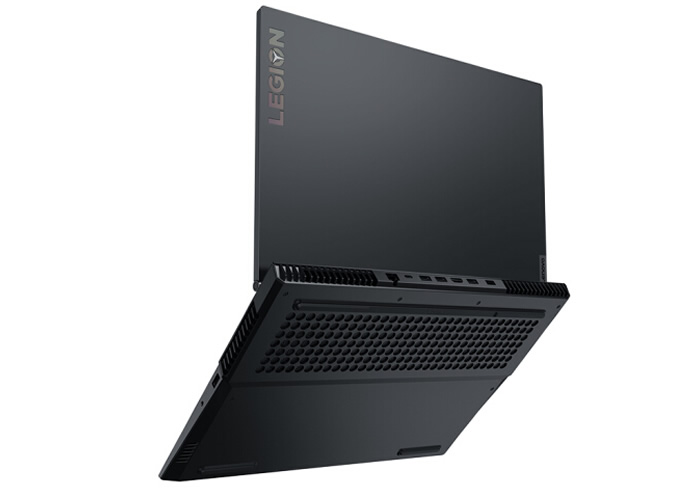
Opening the laptop, we can see that the display comes with a very narrow bezel especially on the sides, which makes the display more immersive. The display also retains the webcam and supports physical switching. Another attractive function of this laptop is a feature that allows the notebook to automatically turn on when users open the top surface. This can be set in Lenovo Computer Manager or Lenovo Vantage. The Lenovo Legion 5i supports opening up to 180°. Although this form is generally not available and it can be regarded as a bonus point.
The keyboard region of this notebook uses a frosted plastic material and it has a relatively small keyboard. At the bottom left corner of the notebook, there is a QR code for Lenovo’s enjoyment service. This is followed by stickers for AMD Ryzen, Radeon, and Nvidia GeForce RTX. The power button is at the top center of the keyboard area while the touchpad is quite smooth which aids easy navigation.
On the bottom, there is a long footpad near the air outlet and two shorter foot pads below. These pads are used to prevent the notebook from easily sliding off a surface. These pads also slightly elevate the notebook thereby increasing the air volume that emanates from the bottom vent. About 30% to 40% of the entire bottom is a vent. We can see that this notebook takes heat dissipation very seriously.
Lenovo Legion 5i Review: Screen
The laptop comes with a 15.6-inch 1920 x 1080 resolution IPS matte screen with a nominal 100% sRGB color gamut and a 165Hz refresh rate.

We used DisplayCal and Blue Spider X to test the screen. It comes with an LCD screen model LP156WFG-SPT2. The sRGB color gamut is 99.7%, the Adobe RGB is 76.2%, the DCI P3 is 81.2% DCI P3. The quality of the screen is very good, and the sRGB color gamut is basically fully covered.
The color accuracy of the display is also another attractive aspect of this device. The maximum brightness of the screen is 359.6nit, and the default color temperature is 6300K. This may appear yellowish for some people. The average color deviation value (Delta E) of the screen is 2.36, and the maximum color deviation value (Delta E) of the screen is 7.48.
However, we observed that Lenovo did not calibrate the color of the display out of the box. Considering that this is an uncalibrated display, the numbers are quite good. The basic quality of this screen is very high and after self-calibration, it can still be competent for simple creative work.
Lenovo Legion 5i: Ports
This device comes with multiple ports on three sides, the two sides and the rear. On the left side of the fuselage, we have the USB-C 3.2 Gen 2 (DisplayPort 1.4) and a Headphone/mic combo port.
On the right side, there is a USB-A 3.2 Gen 1, an E-Shutter button (physical camera switch), and a power indicator light.
Most of the ports are on the rear of this device. On the rear, there are 3 x USB-A 3.2 Gen 1, USB-C 3.2 Gen 2 (DisplayPort 1.4 & power delivery), HDMI 2.1, RJ45 jack, and Power input.
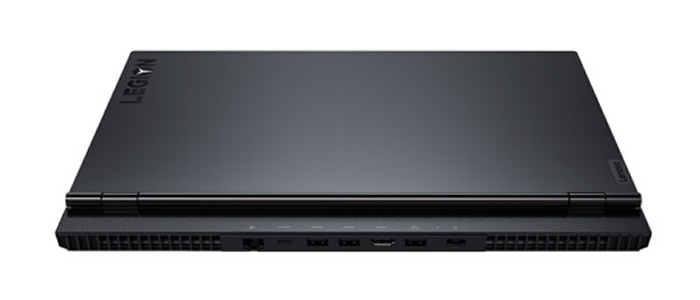
The Lenovo Legion 5i AMD Ryzen 7 5800H version is very complete in terms of interface. We can see that users have a lot of options in terms of connectivity.
Lenovo Legion 5i: Keyboard
The keyboard design in most Legion series is almost consistent. The Legion 5i is no different. The keyboard and keycap design maintains a high standard which has been praised in the market. Firstly, this device comes with a backlight and it also uses a Legion TrueStrike keyboard. The Legion TrueStrike offers “100 percent anti-ghosting, sub-millisecond response times, and soft-landing switches resulting in hair-trigger accuracy”. This significantly improves the precision and trigger speeds. It also offers satisfying keystrokes.

The keystroke of the key is 1.5mm, and it has a slight arc keycap that fits the curvature of the finger. The round keycaps as well as the pretty large 4.7 x 3-inch touchpad make this keyboard more appealing. The keyboard design is much like the Lenovo Legion 5 Pro keyboard.
Lenovo Legion 5i: CPU and GPU
We used CPU-Z to obtain the CPU data for the Lenovo Legion 5i AMD version which was released this year. The CPU information shows that this notebook comes with the AMD R7-5800H processor and this chip is an 8-core 16-thread CPU launched by AMD in 2021. It has a TDP of 45W, uses a 7nm manufacturing process and a 16M three-level cache.
The Legion 5i uses the GeForce RTX3060 which is Nvidia’s latest generation graphics card. This GPU has 3840 rendering units and is Nvidia’s second-generation graphics card that supports ray tracing.
In terms of performance testing, there are various aspects that need testing. We already have the display tests and other features like the CPU, GPU, memory, gaming, and other areas were also tested. This device comes with MUX graphics card switching and three performance modes.
CineBench R15
We used the CineBench R15 platform to test the CPU single-core performance of the notebook’s core display output and graphics card direct-out mode. From the CineBench R15 test, the two modes have almost no impact on CPU single-core performance. Both modes have scores of 234cb and 235cb, which can be regarded as errors.
We also used the CineBench R15 platform to perform 15 rounds of multi-core testing. The test results show that in CineBench R15, the CPU multi-core score in the direct mode graphic card display is slightly higher than the mode score of the core display output. However, in practical terms, the difference is insignificant and most users will not notice it.
CineBench R20
Using the CineBench R20 to test the CPU single-core performance of the notebook’s core display output and graphics card direct-out mode, the results show that the two modes have almost no difference. This is similar to the situation recorded in the CineBench R15 test. The scores are 560cb and 562cb, which can also be regarded as errors.
For the CineBench R20 test for the multi-core, we identified a strange phenomenon. In CineBench R20, the results of the multi-core performance test and the results of CineBench R15 are reversed. The CPU multi-core score of the direct output mode of the graphics card is slightly lower than the mode score of the core graphics output.
We expect both the R15 and R20 results to have the same trends just different figures. As of now, we can not ascertain why there is a reverse in the figures in these tests.
GPU
For the GPU test, we used 3DMark to test different graphics card output modes and different performance modes of the notebook. We also did an accompanying test with Fire Strike Extreme and TimeSpy running scores.
In the 3DMark test, there is no significant difference between the direct output mode and the core display output mode. However, there is a huge difference between the running scores of the smart mode and the beast mode (high-power mode). The difference is as high as 20%.
In the high power mode, the power consumption has a great impact on the running score, and the impact of the core display output will be more reflected in the game. Also, the frame delay will be higher, and the CPU will grab memory bandwidth and power consumption. This will result in a certain degree of game performance decline. Of course, if you are not sensitive to the number of frames and delays, this gap can be completely ignored.
Lenovo Legion 5i: SSD, Memory
We also used CrystalDiskInfo to read the SSD information. From the result, the SSD used by this notebook is Samsung’s PM981A and the capacity of the model we reviewed is 512GB. However, the internal storage goes as high as 2TB. The transmission mode is PCIE3.0 x4, and it supports the NVMe protocol. It is a typical high-speed NVMe SSD with very good performance. The test is performed using CyrstalDiskMark, which shows that the sequential read speed is 3554.5M/s and the write speed is 2968.5M/s. These are typical high-quality NVMe SSD scores.
The Lenovo Legion 5i comes with two 8GB DDR4 3200Mhz memory modules. This means that it uses a dual-memory channel. The memory performance test is performed using AIDA64. The result shows that the memory read and write speed is very good, the memory latency is 76.4ns. Compared to the R7-4800H of the Zen2 architecture, the R7-5800H of the Zen3 architecture has improved memory performance.
Lenovo Legion 5i: Heat dissipation
For the heat dissipation test, we only considered the beast mode (high-power mode). We chose this mode because it will output the highest possible temperature and heat dissipation situation. The room temperature is 19℃, the humidity is 80%, and there is no wind environment. We used the AIDA64 system stability test to assess the heat dissipation capacity.
In the first 10 minutes of the test, the CPU power consumption stabilizes at 76W and the temperature is 80°C. After that, the CPU power consumption remains at 65W. At this time, the CPU frequency is 3.775Ghz and the temperature is 73.6°C. It can be seen that the heat dissipation level of the machine itself is very good, and it gives a more radical performance release.

Just like the CPU test, we also used the AIDA64 system stability test for the FPU test. The Furmark selects 1920 x 1080, and anti-aliasing is turned off for the graphics card test. The room temperature is at 19℃, humidity is at 80%, and there is no wind in the environment.
At the beginning, the CPU maintains 65W power consumption and the graphics card power consumption is 115W. Then the CPU power consumption hits the temperature wall and drops to 45W, however, the graphics card maintains 115W. At this time, the CPU frequency is 3.35Ghz, and the graphics card frequency is 1256Mhz. Also, the CPU temperature is 85.5 ℃ while the graphics card temperature is 75.3℃.
The heat dissipation of the Lenovo Legion 5i AMD version hit its limit under 160W of CPU + graphics card power consumption. If the room temperature is slightly higher, it may hit the temperature limit and reduce the frequency.
Fortunately, the fan noise is not high throughout the testing process. At the highest level, the noise is only 47dB and this is quite good and comfortable. The heat dissipation at the level of 45+115W is also very good for a gaming laptop. However, since the main heat vent is at the center of the rear, most of the heat is let out through the center of the device. Thus, there is a high concentration of heat on the center region of the device and this includes the keyboard. During gaming, users may want to consider using an external keyboard.
Lenovo Legion 5i: Game performance
The game performance test is based on the beast mode (high-power) of the graphics card.
| Game | Resolution | Rendering | Image Quality | Frame Rate |
| Overwatch |
1920 x 1080 | 100% | Super High | 122 fps average, 100 fps minimum |
| Rainbow Six |
1920 x 1080 | 100% | Super High | 266 fps average |
| Grand Theft Auto 5 | – | – | Ultra High | 93 fps average, 59 fps minimum |
| Far Cry 5 | 1920 x 1080 | Extremely high | 109 fps average | |
| Battlefield 5 | – | – | High | 117 fps average, 43 fps minimum |
It is important to note that if you need a higher frame rate, you can reduce the image quality to achieve that. One feature of RTX3060 is ray tracing and this feature automatically improves the frame rate by reducing the image quality.
Summary
As Lenovo’s main gaming product of this year, the Lenovo Legion 5i AMD version has a very satisfactory performance. Whether it is CPU, graphics card, interface, screen quality, and heat dissipation performance, it has a good performance. There are almost no shortcomings in all aspects. The notebook can be said to be very balanced and cost-effective at the same time which makes this device more attractive.
Pros
- Top hardware configuration (5800H+3060)
- Excellent screen (165Hz)
- Excellent number of interfaces
- Good heat dissipation performance (45+115W)
- Good internal scalability (dual M.2 dual memory slots)
- Low fan noise (47dB at full load)
Disadvantage
- The keyboard temperature is slightly higher under high load
- Easily retain fingerprints on the surface of the notebook
- Larger adapter, heavier travel weight
If you need to buy an 8K-priced gaming laptop that has high requirements for performance and screen quality, then you should consider the Lenovo Legion 5i AMD version released in 2021.


